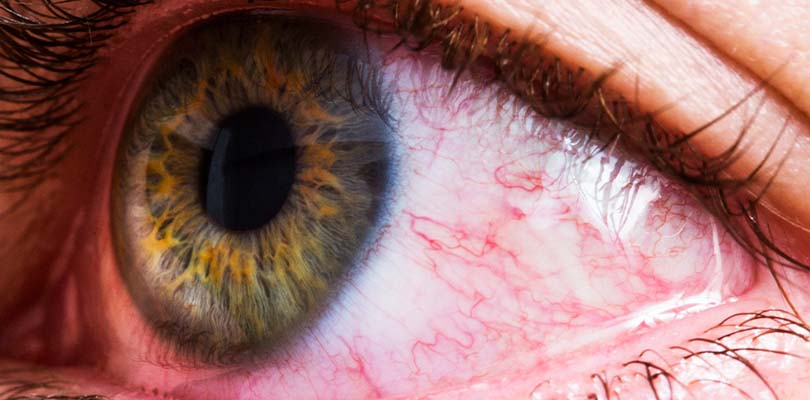What Are the Common Eye Cancer Symptoms?
Melanoma is a type of skin cancer, but are you aware that this type of cancer can start in your eyes as well? While melanomas that start in the skin are more common than melanomas that start in the eye, it still makes a case for the importance of vision protection. There are some eye cancer symptoms to be aware of.
What Is Eye Cancer?
When a group of abnormal cells begin to grow out of control in the eye, the result may be eye cancer. Eye cancer is an uncommon type of cancer that originates within the eye (it is not cancer that has spread from another part of the body—that is secondary cancer). Eye cancer is also called intraocular cancer, which literally translates to “within the eye”. Like other types of cancers, eye cancer can metastasize, or invade other sites and tissues in the body.
What Types of Eye Cancers Are Most Common?
Eye cancers are a rarer type of cancer, but there are a couple types to note. In adults, the most common eye cancers are melanoma and lymphoma. In children, retinoblastoma (which starts in the cells of the retina) is the most common.
Which Parts of the Eye Can Be Affected by Eye Cancer?
There are three major parts of the eye and different types of cancer can start in each of them:
- The eyeball
- The orbit, which consists of the outer tissues surrounding the eyeball
- The accessory structures, such as the eyelids or tear glands
Common Symptoms of Eye Cancer
Early stages of eye cancer may not come with any signs or symptoms, or symptoms may be so minor that you brush them off. As the cancer cells grow and take up more room it can impact the tissue of the eye or affect your vision, which is usually when you will reach out to your optometrist to have a look. In many cases, eye cancer is found during a routine exam (as it rarely causes pain).
Symptoms that you may notice:
- Persistent redness or irritation
- Blurry vision or loss of vision
- Seeing spots or other floaters
- Seeing flashes of light or shadow
- An abnormal dark spot or lump on the eye
- A change in the size or shape of the pupil
- Changes to eye movement
Before you jump to any conclusions about your eye health, be aware that there are other eye conditions that cause similar symptoms to eye cancer, which is why it is important to get the advice of a professional.
Common Causes of Eye Cancer
Cancers are usually the result of many factors, most of which are out of your control. Cancer may develop in folks who have zero risk factors but are subject to unfortunate circumstances and a roll of the figurative dice. Eye cancer affects different genders equally, but after age 50 it is found more often in men.
Mesothelioma is an aggressive and rare type of cancer that originates in the mesothelium of the body and is difficult for doctor's diagnosis.
Known risk factors:
- Those with light colored skin, eyes and hair. People with these features have less melanin.
- Those with atypical skin moles. Research shows that people with certain types of moles have increased risk of developing intraocular melanoma.
- Those who use welding equipment. By profession, welders have a higher risk because of their welding tools. This is likely a result of exposure to ultraviolet radiation (UVR), which is damaging to the eyes.
- Those who use tanning beds. Tanning beds are known to give off UVR.
- Those with HIV or AIDS. The virus weakens the immune system, which increases risk.
Less common risk factors:
- Those with primary acquired melanosis. This condition affects the mucus membrane around the eyes and increases risk of melanoma of the conjunctiva (the name for this particular mucus membrane)
- Those with ocular melanocytosis. This is a rare condition of the eye where those affected have more melanocytes and more melanin in and around the eyes
There are not enough studies to prove whether these other potential risk factors increase the risk of eye cancer, but research indicates they could provide an additional risk. Things like sun exposure, eye moles, genetics and having freckles are things to watch out for.
What Are the Treatment Options?
One of the first treatment options is to have surgery to remove the tumor. Tumor removal generally includes removing some healthy surrounding tissue. Sometimes, the entire eye needs to be removed.
There’s also radiation therapy. This treatment uses high energy particles, such as x-rays, to destroy cancer cells. Along these lines, laser therapy can be used as well. A specialist uses a laser heat to shrink a small tumor.
Of course, there is also active observation and watchful waiting. Some doctors may recommend monitoring what the cancer does before starting active treatment. Waiting may be advisable for slow-growing cancer or instances where jump-starting treatment would do more harm than good.
Can You Prevent Eye Cancer?
Currently, it is not possible to prevent eye cancer since we do not know the cause of most of them. Basic vision protection may help reduce the risk and there are some helpful measures you can take.
Be Smart About Sun Protection
We’re told in order to reduce our risk of skin cancer we should avoid intense sunlight, wear sunscreen, seek shade, wear hats, etc. While the link between sunlight and melanoma has not been proven, advice for vision health is the same as skin health: wear sun protection.
Get Protective Eyewear
Some doctors have the opinion that sunglasses may reduce risk of eye melanoma. Invest in some UV-protected sunglasses when you are out in bright sunlight. The best protection for your eyes is wrap-around sunglasses with 99% to 100% UVA and UVB absorption.
In Review
If you take anything away from this article, let it be the importance of vision protection and eye health. Long days, bright lights and screen time may make for tired eyes, but do not shrug off any symptoms surrounding your vision. Make the time to see an optometrist to ensure you are taking the best care of your eyes that you can.







